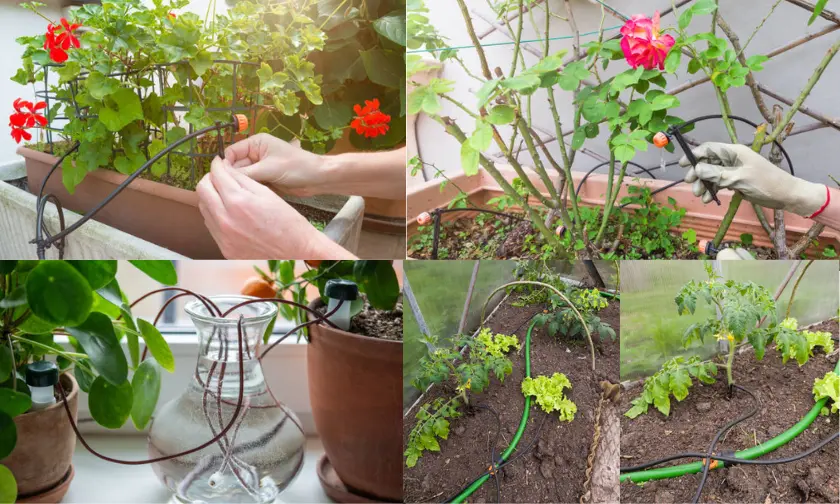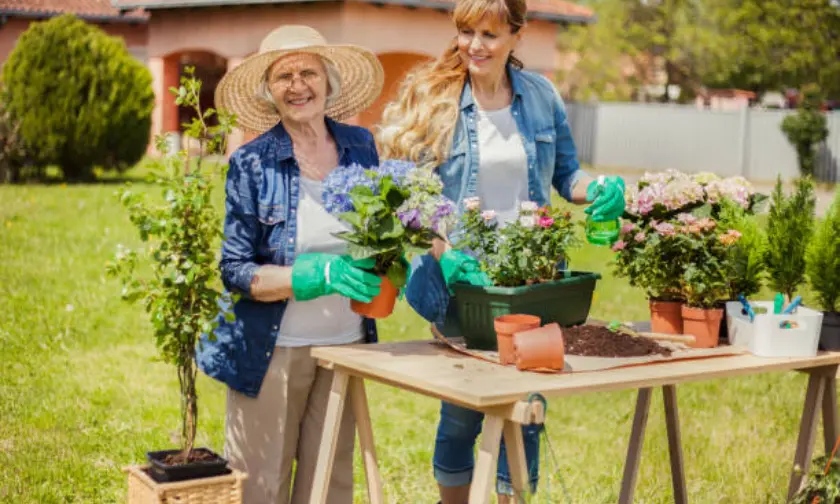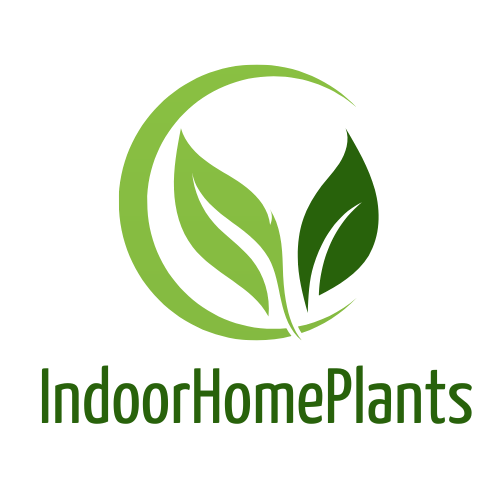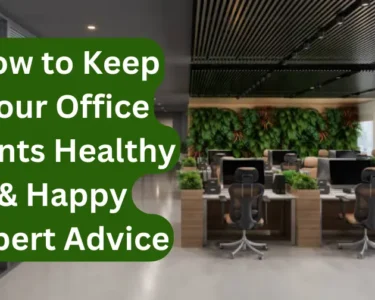How to Keep My Outdoor Plants Watered While on Vacation-Going on vacation is always fun, but plant lovers worry about leaving their outdoor plants alone. You need to keep your green friends hydrated while you’re gone to keep them healthy and strong. This article will show you different ways to water your outdoor plants during your vacation. We’ll talk about practical tips, from setting up automatic watering systems to using clever DIY fixes. After reading this guide, you’ll have a solid plan to make sure your plants stay lush and well-watered, no matter how long you’re away.
Table of Contents
Assess Your Plants’ Water Needs

Know What Your Plants Need
Before you set up a watering system, you need to understand how much water your plants require. Each plant has its own needs. Some might need water every day, while others can last a week without it. Look at the types of plants in your garden and figure out how often each one needs water to pick the best method.
Make It Work for Your Garden
Take succulents and cacti, for example. They need water less often than flowering plants or vegetables do. Knowing these differences is key to keeping your plants healthy and well-watered.
Think About Each Plant
Understanding your plants’ needs is key. Take tomatoes, for instance. They need water more often when it’s hot out. But herbs like rosemary and thyme can handle dry spells better. Make sure you water your garden based on what each plant needs.
Weather Conditions
The weather has a big impact on how much water your plants need. In hot dry times, you might need to water more often. But when it’s cool and rainy, you can ease up. Keep an eye on the forecast and change your watering plan to give your plants just the right amount of water.
Mulching: A Simple Yet Effective Solution

What is Mulching?
Mulching means putting a layer of natural stuff like straw, wood chips, or compost around your plants. This covering helps keep soil wet and cuts down on how often you need to water.
Benefits of Mulching
Mulch works as a shield trapping moisture and creating a steadier space for your plants to grow. It also helps control soil heat and stops weeds. You can set up this simple cheap fix before you head out on vacation.
Installing a Drip Irrigation System

Effective Way to Water
A drip irrigation system ranks among the most effective methods to make sure your plants get steady moisture when you’re not around. These setups supply water right to the plant roots cutting down on evaporation and water waste.
Setting Up the System
You can put drip irrigation systems on a timer, which lets you manage the watering schedule even when you’re far away. Though the first setup might need some money and effort, it offers benefits in the long run by making sure your plants receive the right amount of water without giving too much or too little. This approach works well for bigger gardens or areas with many different types of plants.
Using Self-Watering Planters

Perfect for Container Plants
For container plants, self-watering planters offer a great choice. These planters include a reservoir at the bottom to provide a steady water supply to the plants through capillary action. This ensures plants receive the right amount of water as they need it, without risking too much water.
Easy to Use
Self-watering planters are simple to use and can keep your plants hydrated up to two weeks, depending on the reservoir size and the plants’ water needs. They work well for smaller gardens, balconies, or patios with limited space.
Setting Up a Soaker Hose

Steady Moisture Supply
Soaker hoses offer another good way to water your garden. These hoses let out water all along their length giving steady moisture right to the soil.
Customization and Convenience
You can put them around your plants and hook them up to a timer making sure your garden gets watered on a set schedule. Setting up a soaker hose system isn’t too hard, and you can adapt it to fit your garden’s layout. It works great for flower beds, veggie gardens, and any spots where you need to keep the soil evenly moist.
Using Watering Globes and Spikes

Slow and Steady Watering
Watering globes and spikes serve as useful tools to provide a slow steady supply of water to plants. You can use them by filling them with water and sticking them into the soil. These gadgets release water bit by bit over time keeping your plants well-watered.
Perfect for Small Spaces
Watering globes and spikes work best for single plants or smaller garden patches. They come in different sizes, so you can pick the right one to meet your plants’ needs. This approach also works well as a backup plan if your main watering system stops working.
Asking Neighbors or Friends to Help

A Basic and Trustworthy Fix
At times, the easiest fix is to reach out for assistance. If you have trustworthy neighbors or friends who can keep an eye on your garden, this can be a great way to make sure your plants get water on a regular basis.
Clear Instructions for Care
Give them easy-to-follow directions on how much water your plants need and any special care they might require. Having someone you can count on to look after your plants helps you relax while you’re not there. It also lets someone step in if problems come up, like a broken watering system or sudden weather shifts.
Grouping Plants Together

Managing Watering Requirements
Planting species with similar water needs close to each other can help manage their watering needs. This way ensures each plant gets enough water without giving too much or too little to others.
Making Watering Easier
It also makes things simpler if you use self-watering systems, as you can set them up to meet the needs of specific plant groups. By putting plants in clusters, you can make watering more efficient and keep all your plants healthy. This approach works well for bigger gardens with many different types of plants.
Making a Shade Screen

Guarding Against Too Much Sun
Too much sun can make water evaporate faster drying out the soil and leaving plants thirsty. You can protect your plants from direct sunlight and cut down on water loss by making a short-term shade cover. You can use garden fabric, shade cloth, or even old bedsheets for this.
Easy to Set Up and Change
Shade covers are simple to put up and you can move them around depending on how strong the sun is. They add an extra layer of protection helping your plants stay cool and well-watered even when it’s hot outside.
Using Water Again

Green Way to Water
If you care about the environment, you can use recycled water to keep your plants healthy. Catch rain in barrels or reuse water from washing dishes or clothes to water your garden.
Sustainable Approach
Check that the reused water doesn’t have harmful chemicals and is safe for plants. Recycled water can help your main watering system offering a green way to keep your plants thriving. This method saves water and shrinks your impact on the planet.
Troubleshooting

Even with careful planning, problems can pop up. You need to have a plan to fix issues. If you see your plants drooping or looking sick, look at the watering system for clogs or drips. Make sure timers work right and that water keeps flowing. Check your garden often, or ask a neighbor to do it, to spot and fix any issues .
Mixing Methods

Often, using more than one method gives the best outcome. For example, you can set up a drip system for the main garden and put self-watering pots on your patio. This two-part plan makes sure all parts of your garden get enough water.
Conclusion
Keeping your outdoor plants watered while you’re away needs some planning and imagination. If you know how much water your plants need and use a mix of the methods we talked about, you can relax on your trip without stressing about your garden. You have plenty of options to keep your plants healthy and well-watered. You can set up drip irrigation, use planters that water themselves, or ask your neighbors to help. Enjoy your vacation, and may your garden stay green and full of life!
(FAQ’s)
How to Make Your Own Watering System for Plants?
Setting up your own watering system can save you money and boost your garden’s productivity. Here’s an easy way to build a basic drip irrigation setup:
- Get Your Stuff: You need a big plastic container (a gallon jug works), a sharp pin or needle, and some tubing or bendy straws.
- Set Up the Jug: Put water in the jug and close the lid tight. Poke tiny holes in the bottom with the pin or needle.
- Put the Jug in Place: Set the jug next to your plants. Make sure the holes are close to the bottom of each plant.
- Add Tubing: To aim the water better, stick tubing or straws into the holes and point them at the bases of your plants.
- Adjust the Flow: Try different sizes and numbers of holes to control how fast water flows.
This DIY setup enablesr slow, steady watering, which can help keep your plants consistently hydrated.
Does Leaving Water Out Help Plants?
Letting water sit can help plants in some cases. Here’s what to keep in mind:
- Chlorine Dissipation: Tap water left out for a day allows chlorine to evaporate, which makes it less harmful to plants that are affected.
- Temperature Adjustment: Water that reaches room temperature before use stops roots from getting shocked for plants from warm climates.
- Rainwater Collection: Putting out containers to catch rain provides a green way to get soft water, which works well for most plants.
In general, while water left to stand has its uses in certain situaxts, ensuring consistent watering is more crucial for plant health.
How Do You Water a Garden Hack?
Check out these clever ways to water your garden:
- DIY Water Reservoir: Stick a plastic bottle into the soil close to the plant’s roots. Make small holes in the bottle cap. Fill the bottle with water to create a system that releases water .
- Sponge Method: Put a sponge at the bottom of your pots before you add soil. This helps keep moisture and stops soil from getting too dry too fast.
- Self-Watering Planters: Use two pots one inside the other. The outer pot holds water. The inner pot with the plant sits above it. This lets the roots pull water when they need it.
- Wine Bottle Hack: Take an empty wine bottle and fill it with water. Turn it upside down and stick it into the soil. This keeps plants watered for a few days.
These tricks can help keep soil damp and cut down on how oftenuency of manual watering.
How to Slow Drip Water Plants?
A drip watering system that works makes sure your plants get water . Here’s how you can put it in place:
- Use a Plastic Bottle: Fill a plastic bottle with water and tighten the lid. Make a few tiny holes in the cap.
- Inverted Method: Turn the bottle upside down and push the neck into the dirt near where the plant’s roots are. Water will drip out giving moisture over time.
- Adjust the Hole Size: How big the holes are will change how fast it drips. Begin with small holes and make them bigger if you need to get the flow you want.
- Tubing Alternative: To have more control, put medical-grade tubing into the bottle cap, with the other end placed near the roots.
This approach works great to keep plants watered in warm conditions or when you’re not at home.eather or while you’re away from home.
How Do Plant Self-Watering Devices Work?
Plant self-watering devices have an influence on plant care by using a water reservoir and a wicking system to give plants steady moisture at their roots. Here’s how they work:
- Water Reservoir: The device contains a separate tank for water storage apart from the soil section.
- Wicking System: A wick or porous material pulls water from the tank to the soil through capillary action letting the plant absorb water when it needs to.
- Consistent Moisture: This setup makes sure plants get a steady water supply lowering the chances of giving too much or too little water.
- Low Maintenance: Self-watering devices allow longer gaps between manual watering making them great for plant owners with busy schedules or during vacations.
These gadgets work great for plants in pots. They can keep the plants watered for a few days up to several weeks. How long they last depends on how big the water container is and what the plant needs.
How Do You Make a Garden Watering Bottle?
To create a garden watering bottle, you need to take these steps:
- Pick a Plastic Bottle: Get a clean empty plastic bottle, like a 1 or 2-liter soda container.
- Make Holes in the Cap: Take a needle or pin to pierce 2-3 tiny holes in the bottle cap to allow slow water flow.
- Add Water to the Bottle: Pour water into the bottle and tighten the cap .
- Set the Bottle in the Soil:
- Upside-Down Method: Dig a small hole close to the plant’s base and put the bottle neck-first into the ground.
- Standing Method: For bigger plants, stick the bottle straight up next to the plant. Make sure the holes touch the soil.
- Make Changes if Needed: Keep an eye on how much water flows out. If you need to change the number of holes or make them bigger or smaller. This helps your plants get just the right amount of water.
This homemade irrigation system keeps the soil moist and comes in handy during droughts or when you’re not around. It’s a great way to water your plants without much fuss.
Is a Spray Bottle Good for Watering Plants?
A spray bottle can help water some plants, but it might not work for all:
- Good for Humidity: Spray bottles boost humidity around plants like ferns and orchids that love damp settings.
- Leaf Cleaning: They clean dust off leaves and keep pests away.
- Surface Moisture: Spray bottles give light moisture to seedlings or fragile plants that need gentle care.
- Not Ideal for Deep Watering: Yet, they don’t give enough water to reach the roots of bigger plants so they’re not great for deep watering.
When it comes to most plants, you need to water them more to make sure the roots get enough moisture.
What Liquid Is Best for Watering Plants?
Clean fresh water works best to water most plants, but here’s what you should think about:
- Tap Water: Most plants do fine with it, but if you let it sit for 24 hours, the chlorine goes away. This helps plants that are picky.
- Rainwater: Plants love this stuff. It’s soft and doesn’t have the chemicals you find in tap water.
- Distilled Water: This is good for plants that don’t like the minerals and salts in tap water.
- Stay Away from Sugary or Salted Liquids: These can mess up your plants. They throw off the nutrients or hurt the roots.
When you pick the right kind of water, your plants grow better and stay healthy.
What Is a Good Home Remedy for Watering Plants?
You can use a homemade drip irrigation system as an easy and useful home remedy to water plants:
- Plastic Bottle Drip System: Get a plastic bottle and fill it with water. Make tiny holes in the cap. Then, put it upside down in the soil. This gives the plant’s roots a slow and steady supply of water.
- Compost Tea: Try compost tea as a natural plant food. Soak compost in water for a few days. Strain it and use the liquid to water your plants. This gives them both water and nutrients.
These methods help keep soil moisture steady and can boost plant health without much work or money.
Is Rice Water Good for Plants?
Yes, rice water has benefits for plants. It contains nutrients like vitamins, minerals, and amino acids that help plants grow. You can use it as an extra fertilizer:
- Nutrient Boost: It gives more nutrients to make soil better and plants healthier.
- Dilution: Mix it with water before you use it so starch or too many nutrients don’t build up.
- Application: Put it right on the soil or spray it on leaves to give plants a gentle nutrient boost.
Don’t use too much rice water. Using a lot can lead to too much fertilizer or mold growing.
Thank you for visiting IndoorHomePlants.com. We hope you find our website helpful and inspiring as you embark on your plant care adventures! Click Here See More Related Articles! 🙂






4 Comments